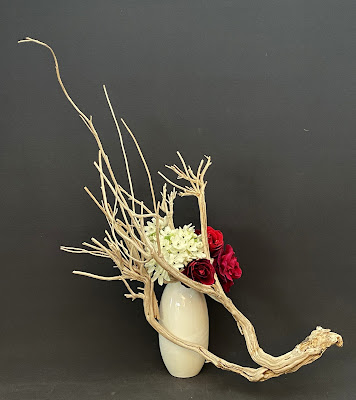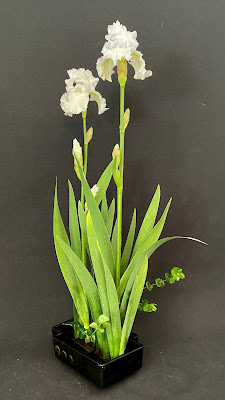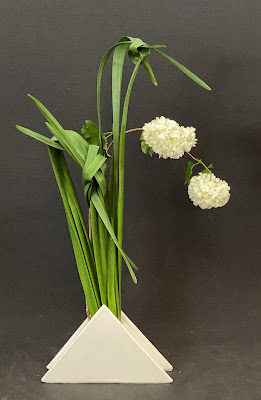Hello all,
Sam commented that the above arrangement looks like a sailing ship. I suppose it does, now that I think about it, especially the shape of the container. The painted branch material is from a pomegranate tree. It is the new growth from where a large limb had been removed. The flowers are cymbidium orchids and the leaves are dietes in a resin container.
All around our area there are flowering callistemons. They make quite a show. I was particularly taken with this pink one and felt it would be ideal for a basket arrangement. The white of the ornithogalum enhances the bright pink of the callistemon.
I'm continuing to enjoy the flag iris, which have a short lifespan but, as I mentioned before, I have a lot of them and they continue to flower. Below is an arrangement in the traditional style but in two containers and using two different coloured iris. The rhizome for the one on the right was given to me by a former student, Lyn Thomas, who referred to it as 'flesh coloured'. I spent some time searching for it on the internet, where I found a catalogue of 102 different coloured flag iris but it was not amongst them. I found it, eventually, in an old book on iris that I've had for decades. I'm quite confident that it is the one called 'Smoke Rings'


Our scheduled Ikebana International workshop for October was conducted through Zoom, with Christopher James demonstrating and answering questions. He chose the theme of 'An arrangement of Spring Flowers in a nageire vase'. He went on to explain that, according to strict Sogetsu rules, only flowers that are available in spring and that do not grow on branches or vines are to be used. Christopher demonstrated this in his first arrangement but, taking in to consideration that there are other schools of ikebana, in his second arrangement he used native branch materials. We, the members, were then required to make our own arrangements and send the photographs to the secretary to be included in our instagram page. For those of you on Instagram our account is - ikebanainternationalmelbourne
As a Sogetsu teacher, I wanted to adhere to our rules regarding the suitability of flowers for this exercise and I was waiting for some flowers to open before I made my arrangement. Because they were taking too long, I opted for using different but available materials - coral aloe, clivias and flag iris in a large, ceramic vase.
However, just before the cut-off date, I managed to coax my hippeastrum to flower by putting the stem in warm water overnight. Also, the ornithogalums opened up sufficiently to be used. This is my preferred arrangement. Also, I'm particularly fond of this lacquered nageire container.
I had quite a few of the coral aloe left over prompting me to try using them in a way other than a mass. They have interesting lines and side shoots, that I wanted to focus on. Looking around the garden for complementary material, the strelitzia reginae was a no-brainer. The 'container' is a platter with holes in it sitting on top of a large suiban with kenzans in it.
Rummaging around one of my very cluttered storerooms, I came across this travertine, tsubo vase, that I haven't used in decades. Still in the storeroom, I found this dry branch material that worked very well with the container. The flowers are orange and yellow clivias and ornithogalums.
This year, for the first time, some of the flowers of my viburnum opulus are so big that they look like large hydrangeas. Unfortunately, because of the weight of these large flowers, they break away from the stem and can't be used. This arrangement, below, was one way of using such a flower with its very short stalk.
Bye for now,
Emily





































